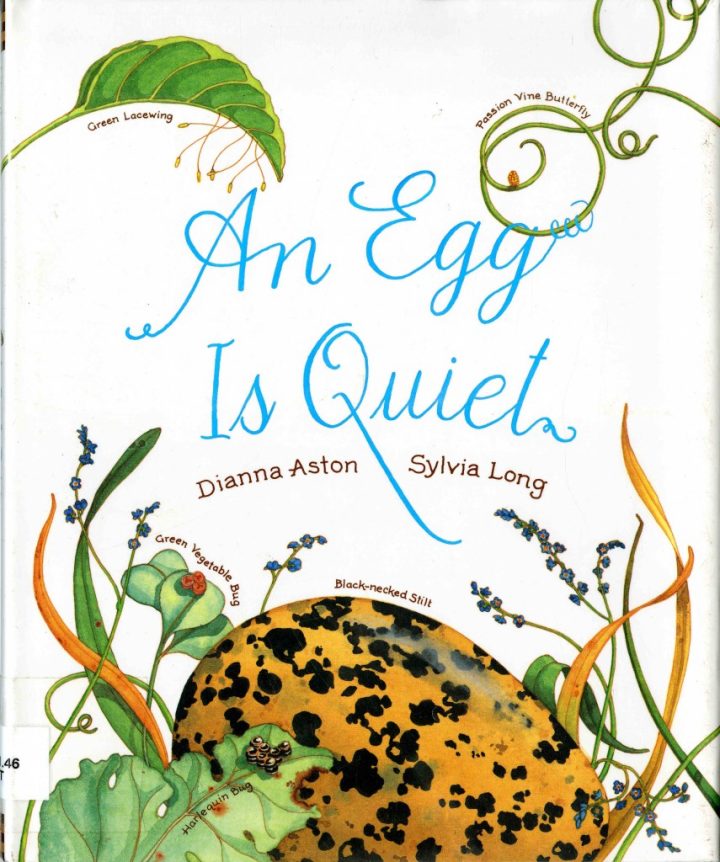An Egg is Quiet
An Egg is Quiet by Dianna Aston, illustrated by Sylvia Long

Topic: Diversity of Eggs
Description:
With an introduction to over 60 different kinds of eggs (from huge ostrich eggs to the fossilized eggs of dinosaurs), students will discover the many colors, textures, shapes and sizes an egg can have while exploring fun facts about the eggs and their owners along the way.
Activity 1: Before reading activity
Explore kids’ experience with eggs. For example:
- What does the outside of an egg look like? Feel like?
- What does the inside of a bird egg look like?
- What kinds of animals lay eggs?
After reading the book, kids might be surprised how many different shapes and colors eggs can be.
Activity 2: Camouflage
The egg of the Sooty Tern uses camouflage to blend in to its surroundings of speckled rocks. First, describe camouflage as a way for the eggs to hide. Using the page about camouflage in the book, show students how the egg blends in by having the same colors and patterns as the surroundings.
Next, go outside to the schoolyard and have children find a place where they are camouflaged. Have one or two children try to spot the camouflaged students without moving from a central location. How long did it take them to spot everyone? What were the hardest colors to spot? Were any of the students wearing colors that didn’t work as camouflage in the schoolyard? Explain that some eggs that don’t use camouflage are bright colors like the blue of the Robin’s egg.
Use what you’ve learned about the best colors and locations to camouflage in your schoolyard by challenging kids to design their own egg. Whether through painting plastic eggs or coloring a picture of an egg, have students think about the best colors and patterns to use for an egg to hide in their schoolyard. Have students share their eggs and ask: Where in the schoolyard would your egg best be hidden? What kind of bird do you imagine would lay the egg you designed? You can even play another round of camouflage by having students hide their eggs in the schoolyard to test how well their designs blend in.
Activity 3: Egg-sploration!
Using an egg from the grocery store, have children examine the different parts of it, from the shell to the yolk.
First, ask the children to gently pick up their egg and take a close look at the outer shell. What color is it? What does it feel like? What is the shape?
Next, gently crack open the eggs for the students, being careful not to break the yolk and keeping the shell as intact as possible.
Have children first look at the inside of the shell. Does it look and feel the same as the outside of the shell? Point out the air sac.
Then have students look at the egg white, or albumen. What color is it? What is the texture? Next, the children will look at the yolk. What color is the yolk? What is the shape of the yolk? Invite children to break the yolk and observe what happens.
For information about the parts of the egg, we recommend a visit to the 4-H Virtual Farm.
Activity 4: Build your Own Nest
Have children build their own “nest” from natural materials they gather outside, or that you provide. Materials can include sticks, tiny twigs, leaves, mud, pine needles, dried grass, and plant fluff (cattails, milkweed seeds, etc.). They can test their nest’s ability to hold “eggs” by putting 2-3 small rocks in the nest and then placing it on a y-shaped tree branch. If there are any nests that will not pass this test, but are well-made, perhaps they are for ground-nesting birds!
Activity 5: NestWatch
Look for nests in your area and join the Lab’s NestWatch project. NestWatch allows anyone to follow the life cycle of the birds nesting in their neighborhood and collect simple data to contribute to a national database. Get the insider’s view of nesting birds, and learn how you can become a NestWatcher!
Activity 6: Nest Cams
Check out the live Nest Cams to observe nesting season in the wild. Follow along with the Life in a Nest activities (available as a free download!) to engage your students in science and birds through the live cameras! Additionally, the May lesson of the Feathered Friends resource (also a free download!) explores chicks in their nests and ties to the Nest Cams.
Additional Resources and Supplies
- Peterson Field Guide To North American Bird Nests by Casey McFarland, Matthew Monjello, and David Moskowitz
- Nests and Eggs of North American Backyard Birds Pocket Field Guide from the NestWatch Project